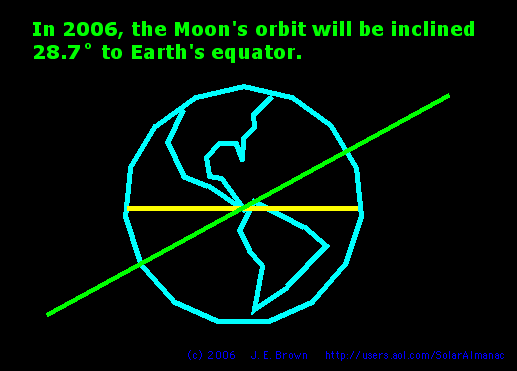 A press release from The Solar Almanac.
A press release from The Solar Almanac.
 A press release from The Solar Almanac.
A press release from The Solar Almanac.
Date: September 4, 2006
by J. E. Brown
The northernmost moon of the 21st century will occur on September 15, 2006.
Many viewers will see the Moon climb unusually high in the sky; a few will see the Moon directly overhead.
This event will be visible in every time zone. For viewers in the Northern Hemisphere, north of the tropics, this moon will be the highest until 2024, with the Moon appearing directly overhead as far north as The Bahamas, Iran, Nepal, Delhi, and the southern ends of Morocco, Kuwait, and Tibet. In the US, the Moon will be overhead in Florida (Cape Canaveral) and southern Texas, and not quite as far north as the Louisiana Delta.
Observers in the Southern Hemisphere will see an unusually low Moon to the north. Observers below 60 south will see a very low moon or none at all. At all locations, the Moon will rise and set near its extreme northeast and northwest azimuths (unusually far NE/NW on the horizon).

|
The Moon spends all of its time oscillating between Earth's northern and southern hemispheres, lingering at middle latitudes for about a day before heading back for the other side of the equator.
At a high moon, the Moon reaches its peak declination (earth latitude), and then starts moving back toward the equator. Within 12 hours of that event, each time zone on Earth rotates into position underneath the Moon. The Moon remains within 0.2° of its peak latitude for 24 hours, so every time zone gets an equally good show.
This month's peak occurs at 1:27 UT on Sept. 15, when the last-quarter moon will be overhead at 28°43' N, 73°15' E, a bit west of New Delhi, India.

|
The Moon will be high but not full. For technical reasons, full moons do not occur at declinations more extreme than 28.40 degrees.
In North America, the October moon will culminate slightly higher than September's, and the March 2006 moon was even higher than that.
Most of the extreme moons of 2006 will be about equally good, so if you miss this one, don't worry, another will occur 27.3 days later.
To enjoy this rare phenomenon, go outside around sunrise the morning of September 15, look up, and notice how high the Moon is.
For observers north of 29°N, this will be the highest moon all century. Not only is this the northernmost moon of the current 18.6-year lunar cycle, but the Moon's orbit as a whole is undergoing a long flattening trend, caused by a tiny slow decrease in the obliquity of the ecliptic (the 23.4° inclination of Earth's equator to its orbital plane). Earth's equator, Earth's orbit, and the Moon's orbit are all becoming more parallel. The change is on the order of an arcminute per century, so unless you use precise instruments, you won't see any difference, and you'll continue to see and enjoy a cluster of breathtaking high moons every 18.6 years.
A series of high moons occurs every 18.6 years. In each hemisphere, high moons occur on average every 27.3 days, when the Moon is at its farthest from Earth's equator. During peak years, the Moon rides 5° higher than average, and 10.3° higher than its minimum. This affords you a rare chance to see the Moon directly overhead if you happen to be at a latitude of 28.7° north or south. (Or you could travel to the tropics, where the Moon is overhead twice a month, every month, every year; look at all the culminations over Africa.)
The record high moon for Southern observers occurred in March, but a very close second will occur on Sept. 29 with peak declination at 20:33 UT, favoring South America and Easter Island and the northern ends of Lesotho, New South Wales, and South Australia. At the same time, Northern Hemisphere viewers will see a remarkably low moon.
J. E. Brown lives and breathes astronomy in Los Alamos, New Mexico USA. (more)
| mini•blog' |
"This week, astronomers announced the dwarf planets: |
18.6 years, extreme declinations of the Moon, northernmost declination of the Moon, southernmost declination of the Moon, lunar standstill
 The Solar Almanac: This month's events in astronomy. Never miss a moon event.
The Solar Almanac: This month's events in astronomy. Never miss a moon event.
 Aurora Borealis over New Mexico
Aurora Borealis over New Mexico
Copyright © 2005-2006 J. E. Brown all rights reserved. write me here Los Alamos, NM USA